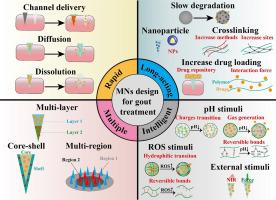治疗痛风性关节炎的微针透皮给药:材料结构、设计策略和前景。
IF 9.4
1区 医学
Q1 ENGINEERING, BIOMEDICAL
引用次数: 0
摘要
痛风性关节炎(GA)是由单钠尿酸盐(MSU)结晶沉积引起的。痛风性关节炎的发病机制复杂,而且容易复发,因此很难治愈。痛风患者需要长期接受降尿酸和抗炎治疗。近十年来,微针(MNs)给药作为一种无痛、方便、耐受性好的新型透皮给药方法不断被开发出来,可实现多种药物释放模式以应对各种复杂疾病。与传统的给药方式(口服和注射)相比,微针因其安全、高效、可控的给药能力,更有利于GA患者的长期独立治疗。本综述概述了 GA 的病理机制和 GA 的常用治疗药物。随后,总结了MNs的给药机制:溶解释放机制、膨胀释放机制和通道辅助释放机制。根据 MNs 的给药模式,综述了速释 MNs、长效 MNs、智能释放 MNs 和多重释放 MNs 的机制和应用。此外,还讨论了 MNs 在治疗 GA 方面的现有问题和未来趋势。重要意义痛风是一种由代谢性疾病 "高尿酸血症 "引起的关节炎。流行病学研究表明,痛风患者人数在全球范围内迅速增加。由于痛风的发病机制复杂且反复发作,痛风患者需要长期治疗。然而,传统的给药模式(口服和注射)依从性差,药物利用率低,缺乏局部靶向性。它们还可能导致皮疹和胃肠道反应等不良反应。微针作为一种无痛、方便、耐受性好的新型透皮给药方法,已被不断开发出来,可实现多种药物释放模式,用于治疗痛风性关节炎。本综述将对治疗痛风性关节炎的微针的材料结构、设计策略和未来展望进行综述。本文章由计算机程序翻译,如有差异,请以英文原文为准。

Microneedle transdermal drug delivery as a candidate for the treatment of gouty arthritis: Material structure, design strategies and prospects
Gouty arthritis (GA) is caused by monosodium urate (MSU) crystals deposition. GA is difficult to cure because of its complex disease mechanism and the tendency to reoccur. GA patients require long-term uric acid-lowering and anti-inflammatory treatments. In the past ten years, as a painless, convenient and well-tolerated new drug transdermal delivery method, microneedles (MNs) administration has been continuously developed, which can realize various drug release modes to deal with various complex diseases. Compared with the traditional administration methods (oral and injection), MNs are more conducive to the long-term independent treatment of GA patients because of their safe, efficient and controllable drug delivery ability. In this review, the pathological mechanism of GA and common therapeutic drugs for GA are summarized. After that, MNs drug delivery mechanisms were summarized: dissolution release mechanism, swelling release mechanism and channel-assisted release mechanism. According to drug delivery patterns of MNs, the mechanisms and applications of rapid-release MNs, long-acting MNs, intelligent-release MNs and multiple-release MNs were reviewed. Additionally, existing problems and future trends of MNs in the treatment of GA were also discussed.
Statement of significance
Gout is an arthritis caused by metabolic disease "hyperuricemia". Epidemiological studies show that the number of gouty patients is increasing rapidly worldwide. Due to the complex disease mechanism and recurrent nature of gout, gouty patients require long-term therapy. However, traditional drug delivery modes (oral and injectable) have poor adherence, low drug utilization, and lack of local localized targeting. They may lead to adverse effects such as rashes and gastrointestinal reactions. As a painless, convenient and well-tolerated new drug transdermal delivery method, microneedles have been continuously developed, which can realize various drug release modes to deal with gouty arthritis. In this review, the material structure, design strategy and future outlook of microneedles for treating gouty arthritis will be reviewed.
求助全文
通过发布文献求助,成功后即可免费获取论文全文。
去求助
来源期刊

Acta Biomaterialia
工程技术-材料科学:生物材料
CiteScore
16.80
自引率
3.10%
发文量
776
审稿时长
30 days
期刊介绍:
Acta Biomaterialia is a monthly peer-reviewed scientific journal published by Elsevier. The journal was established in January 2005. The editor-in-chief is W.R. Wagner (University of Pittsburgh). The journal covers research in biomaterials science, including the interrelationship of biomaterial structure and function from macroscale to nanoscale. Topical coverage includes biomedical and biocompatible materials.
 求助内容:
求助内容: 应助结果提醒方式:
应助结果提醒方式:


